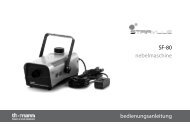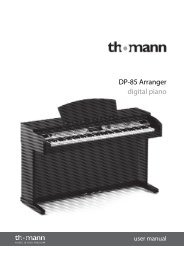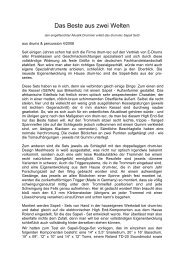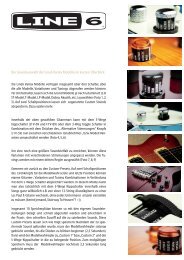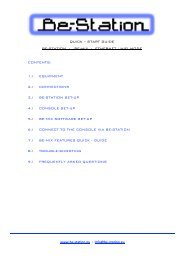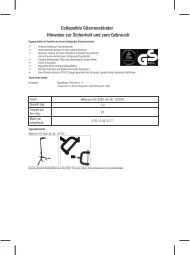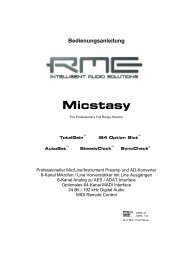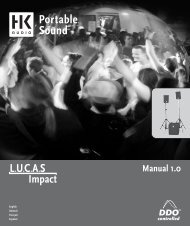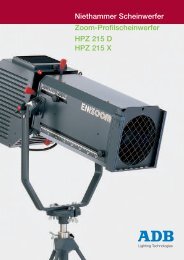Create successful ePaper yourself
Turn your PDF publications into a flip-book with our unique Google optimized e-Paper software.
3:3 Introduction to BFD2 mixer channels<br />
Channel views<br />
BFD2 features two distinct channel strip views.<br />
Regular view<br />
This is the default channel strip view in BFD2. If the FX and Send slots are showing, disable the<br />
FX/Sends view button in the toolbar to switch to the Regular view.<br />
Regular view displays a long throw fader and any essential additional controls, such as mute,<br />
solo, Record-enable, phase flip and the channel context menu button.<br />
FX/Sends view<br />
If the Regular view is currently displayed, enable the FX/Sends view button in the toolbar in order<br />
to switch to the FX/Sends view.<br />
This view consists of a smaller fader section and a readout of the 4 effect and send slots.<br />
In addition, aux channels and the master channel have a couple of advanced controls for<br />
setting main input and sidechain trim.<br />
This view is designed to allow you to see the FX and sends of more than one channel<br />
simultaneously. If you do not need to do this you can stick to the Regular view, although if you<br />
need to use the extra aux and master channel input and sidechain trim controls, you must switch<br />
to FX/Sends view.<br />
Types of channel strips in BFD2<br />
Channel strips appear in the mixer dynamically, depending upon what kit-pieces are currently loaded and what mic channels they<br />
contain. There are various types of channel:<br />
Kit-piece Direct channels<br />
Each kit-piece slot that currently has a kit-piece loaded is represented by a number of direct<br />
channel strips on the mixer:<br />
• the primary direct mic(s)<br />
• the bleed mics<br />
Direct channels can be hidden by deactivating the Direct mixer view switch in the toolbar. To<br />
reveal them again, activate the button.<br />
Primary Direct mic channels<br />
Kick and snare kit-pieces are special within BFD.<br />
Whenever a kick is loaded into a slot, it is represented by 2 primary direct channels in the mixer,<br />
for the inside and outside kick mics. These can be identified by the colour of the tabs at the top of<br />
each channel:<br />
• primary direct mics are green<br />
• secondary direct mics are teal<br />
Whenever a BFD2 snare is loaded into a slot, it is represented by 3 primary direct channel strips<br />
in the mixer: there are 2 mics above the BFD2 snares, and another below them.<br />
When a BFD library that does not contain 2 snare top mics is used, only 2 direct channels are<br />
available. If you replace a BFD2 snare with, say, a BFD Jazz & Funk snare, the snare top2 channel<br />
is unused (its coloured tab turns grey) until a 3-channel snare is reloaded into the slot.<br />
Other types of kit-pieces are represented by a single primary direct mic.<br />
Bleed mic channels: the kick1 and snare1 channels<br />
The kick1 and snare1 kit-piece slots have further unique properties. They carry bleed: the sound of other kit-pieces through the 2<br />
kick mics and the first 2 snare mics. The snare top 2 channel in BFD2 does not contain bleed.<br />
These channels, like ambience channels, appear when any kit-piece is loaded into any available slot.<br />
This occurs even if all bleed is turned off in the kit-piece inspector bleed controls, or if it is routed to primary direct mic channels.<br />
Imported kit-piece channels<br />
If you load a kit-piece created by BFD2’s sample import function, it is represented by a single direct channel in the mixer, either<br />
mono or stereo depending upon the samples in the kit-piece.<br />
Imported kit-pieces have no ambience or bleed channels.<br />
Direct snare channels<br />
in FX/Sends view<br />
Direct snare channels<br />
in Regular view



